A Return to L'Isle-sur-la-Sorgue
We returned to this daring village nestled along the Sorgue River, with its fresh emerald green waters. L'Isle-sur-la-Sorgue is dotted with mossy paddle wheels, vestiges of the textile industry which ensured the prosperity of the city
We had returned to experience its living cultural heritage: the Provençal market. On Thursday and Sunday mornings, crowds flock to the streets of the city, the scene of a colorful market which offers tasty vegetables, cheeses and regional wines, among numerous other products offered at the merchants' stalls.
Another destination was the Villa Datris for its current exhibit, FAIRE CORPS.
The 14th exhibition, hosted in this beautiful 19th century house, explores various visions of the body through the works of 60 established and emerging artists, both French and international. In the Foundation's human-scale spaces and in its gardens, we explored various facets of this classic but relevant subject.
Instead of doing a deep dive on each piece, I'll let you admire some of our more favorite works. Keep in mind "FAIRE CORPS critiques the transcendent physical body, a central site to capitalism, along with the body's role in social injustice, immigration, bioethics, cybernetics, wars, and contagions, as well as the body as a militating ecological force."
In addition, "Since the 19th century, and in keeping with profound mutations in society, representations of the "classical" body and the ideal nude have been increasingly called into question. In this exhibition, we explore the body as an object of concern for racialized, feminist, and gendered representations."
I have been a fan of Niki de Saint Phalle and was excited that so many of her pieces were here. "Women's bodies have long been subjected to a heteronormative gaze. With their focus on interiority, artists such as Niki de Saint Phalle propelled female representation into new terrain. In liberating women's voices, some artists focus on parts of the body traditionally controlled by the male gaze, while others denounce the emptiness and commodification of stereotypical female representation."
In 2010, we spent a month in Charleston and went to an exhibit showcasing the work of Nick Cave. What a coincidence to see him again here, in France. His Soundsuits are weirdly intriguing, wearable mixed-media sculptures which incorporate every material imaginable to make sounds unique to each garment. Here's a video to know more about the artist and his unique work. Wow!
A key member of the New Realism movement of the 60s, César created his first self-portrait Le Pouce (The Thumb) in 1965. That work launched a lifelong pattern of revisiting the symbol, experimenting with materials and sizes, developing the sculpture into a recognizable emblem. Hmmm.
Interestingly, we had the opportunity to admire one of César's Thumbs when we were in Paris in 2011. Another strange art related coincidence.
"The body is in the world as the heart is in the organism:
it keeps the visible spectacle continuously alive,
animating and nourishing it from within.”
-Maurice Merleau-Pont
After the art museum we visited an art gallery. We fell in love with Myriam Louvel Paoli's wire sculptures.She wrote about her work, "I tangle the wires, the shapes and their ghosts of shadows... I create "objects" for meditation, for questions. I remake objects from the world in wire... to gain a foothold, understand, incorporate. The wire traces. The wire draws in space and sculpts the void. It questions the relationship between form and content. How does it hold? What does it hold on to? The important thing is that it holds, that something holds. Sometimes an object finds his answer, or his question, in another, later, which pushes me to move forward. At first, I let come with the least possible awareness what inhabits me. Destabilizing inner adventure, the interesting being what escapes me. In a second time, sometimes, it makes sense in my story. But it only really comes to fruition, in my opinion, when it touches someone else and moves something in them..." They certainly moved something in me. Wow.
As for this piece, I only include it because I was able to adorn it with a sunflower. I left my mark on L'Isle as it has on me.
L'Isle-sur-la-Sorgue is a town historically marked by wool and silk work. It was able to take advantage of all its natural resources (water and its driving force, wool, thistle, madder, olive oil, etc.), which its inhabitants developed by equipping themselves with water wheels, up to 66 in its heyday, which fueled mills, spinning machines, later mechanical looms.
Of all the business established on La Sorgue, only one remains. It is at the heart of this environment favorable to the textile industry that in 1808, a duo installed a parlor mill on the banks of the river, and began creating woolen sheets and blankets. By 1900, five integrated factories and numerous more specialized workshops still produced wool blankets, Avignon rugs, sheets for clothing and technical fabrics for stationery. Now 215 years later, only Brun de Vian-Tiran continues its activity, for which 8 generations have succeeded one another in an uninterrupted manner, perpetuating this unique manufacture in France.To wander around villages near and far. To discover uniqueness just around a corner. To hug a tree who is as old as America. Is it any wonder we travel? This stay in France has exposed us to such an array of delights!

%20(Medium).jpg)
%20(Medium).jpg)
%20(Medium).jpg)
%20(Medium).jpg)
%20(Medium).jpg)
%20(Medium).jpg)
%20(Medium).jpg)
%20(Medium).jpg)
%20(Medium).jpg)
%20(Medium).jpg)
%20(Medium).jpg)

%20(Medium).jpg)
%20(Medium).jpg)
%20(Medium).jpg)
%20(Medium).jpg)
%20(Medium).jpg)
%20(Medium).jpg)
%20(Medium).jpg)
%20(Medium).jpg)
%20(Medium).jpg)
%20(Medium).jpg)
%20(Medium).jpg)
%20(Medium).jpg)
%20(Medium).jpg)

%20(Medium).jpg)
%20(Medium).jpg)
%20(Medium).jpg)
%20(Medium).jpg)
%20(Medium).jpg)
%20(Medium).jpg)
%20(Medium).jpg)
%20(Medium).jpg)
%20(Medium).jpg)

%20(Medium).jpg)
%20(Medium).jpg)
%20(Medium).jpg)
%20(Medium).jpg)
%20(Medium).jpg)
%20(Medium).jpg)
%20(Medium).jpg)
0 comments:
Post a Comment